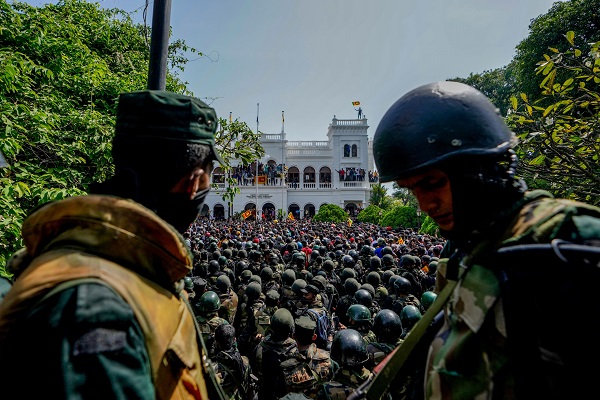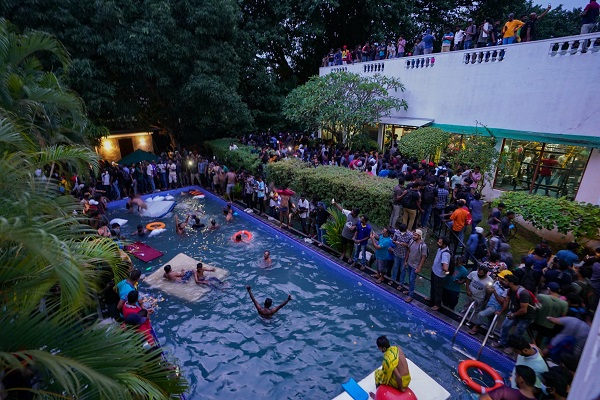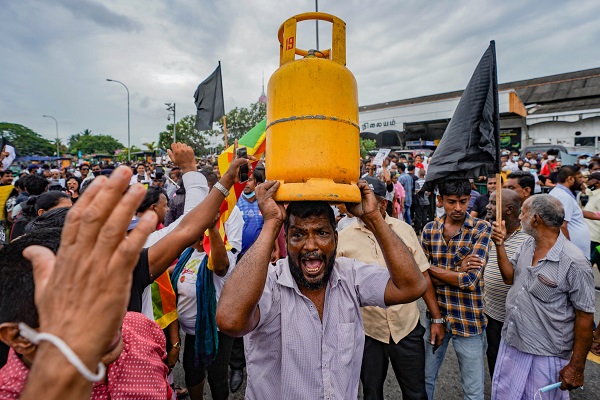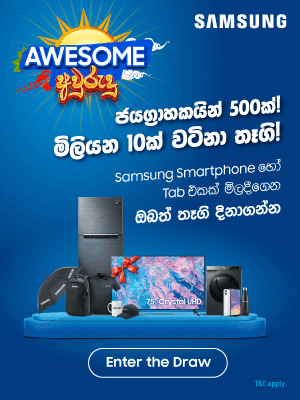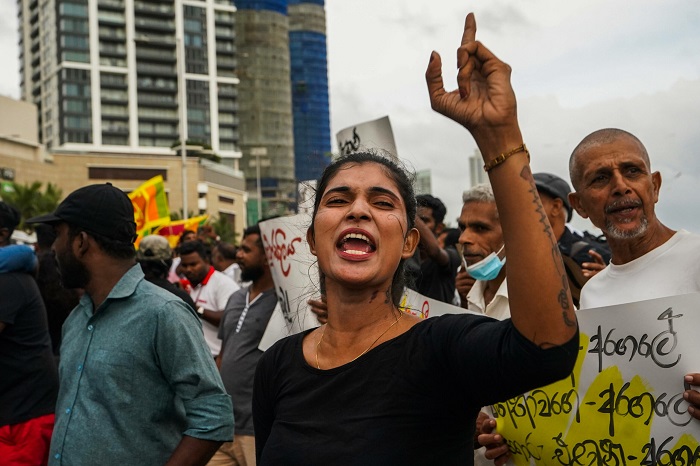
Thilina Kaluthotage, known in Sri Lanka as the ‘Eye of the Struggle,’ has documented the recent crisis in all its forms. IMAGO spoke to him about his career and Sri Lanka’s future.
The self-made photojournalist has become a voice for his people, capturing the different aspects of the economic crisis, from daily life in Colombo and the protesters who stormed the streets, to those who made themselves at home in the Presidential Palace.
His photos of thunder striking Colombo’s Lotus Tower and the International Space Station passing in front of the moon, are what first put him on the map. Now sponsored by CameraLK and signed with NurPhoto agency, a partner of IMAGO, his photos are being published in newspapers worldwide and he has even been on television. Originally from the village of Rarnapura, about 130 km from Colombo, Kaluthotage took the current crisis as an opportunity to turn to photojournalism and tell the story of the struggle – given the nickname ‘The Eye of the Struggle’ by the people himself.
Images of civilians indulging in the former president’s luxuries as they stormed his palace symbolize the essence of Sri Lanka’s economic crisis – fueled by nepotism, corruption and wealth inequality. He shares his story and what’s ahead for our New Narrative series.
“The most valuable thing I have seen in this crisis of 2022 is that people are not afraid of politicians…[they] were very happy after taking possession of the President’s Palace. They bathed in the swimming pool, slept in the president’s bed and had fun at the gym.”
First off, thank you for speaking with us in such a hectic moment in history. The world was now suddenly watching Sri Lanka as the political and economic crisis escalated, but I am curious about how we got here. As a Sri Lankan photojournalist, can you tell us a bit about the situation over the years that has led to this new reality?
Our country had almost 30 years of civil war [1983-2009] followed by the sudden Easter attacks [2019], and it was during this period that the country became politically unstable. There have been problems since the 1980’s, but the people of our country were afraid of politics and politicians until recently.
The most valuable thing I have seen in this crisis of 2022 is that people are not afraid of politicians. Parliamentary power in Sri Lanka is passed from father to son and then to their sons, and many of the older generation were enslaved to those political families. But the next generation is not like that, and I think this is a good thing for the future.
Due to the recent acute fuel crisis, all I could see were long fuel queues and people suffering from the loss of jobs. Although I was able to cover it from the photojournalism side, it is very sad for me that the people of our country are living this way.
You photographed as the protesters stormed the ex-president’s home. I’m hoping you can set the scene for us — what was it like seeing everyone take over, what was the atmosphere and mood?
From the beginning of 2022, this crisis came forward step by step, but after the month of May, it severely affected the country and the people. People join the struggle day by day. People from far away camped in Colombo and those with money provided them with food and other necessities. On July 9, the people of the country gathered in Colombo and created a wave through social media to throw out the then-President, Gotabhaya Rajapaksa.
In the early morning of July 9, I went to the Galle Face beach promenade and I could see that the security forces had used strict protection – I hadn’t seen such protection in a while. At around nine in the morning, people blocked all the roads leading to the president’s house. Along with that, the security forces fired water and tear gas non-stop. People came to Colombo from all over Sri Lanka by train and bus; That day, I saw the biggest crowd I’ve seen in a long time.
Somehow, the security forces lost control, and the water cannons were taken over by the people and the first gate was demolished. A few moments later, the security forces fired shots at the surrounding walls but the protesters were not afraid and occupied the palace. I was already tired from the tear gas attacks, water was my only food, but I covered all those events from one of the tallest buildings in Colombo.
The people were very happy after taking possession of the President’s Palace. They bathed in the swimming pool, slept in the president’s bed and had fun at the gym. There was talk about how comfortable the country’s president is with this. People from all over the country came for days to witness and it was controlled by the people themselves for days before being handed over to the security forces.
Sri Lanka has a new president now after Gotabaya Rajapaksa fled amidst the mass protests, do you have hope for your country’s future?
Ranil Wickramasinghe managed to solve the fuel problem to some extent after he took over as the new president – the fuel queues of the past are no more. The ration system means people get the oil they need for daily work, but his support is lessening because those who stormed into the President’s House, the Prime Minister’s Office, and other places involved in the struggle were found and arrested. Even more so, the appointing of former ministers as new ministers [such as Wickramasinghe, who has served as Prime Minister five separate times and is also the current Minister of Finance], is something people are hoping to change in the next election.
Your photos at the protests show an incredibly intense scene, some have even died in the chaos. How are photographers’ treated by the police and protesters? Can you tell me some challenges you faced? What moments stood out to you the most?
Actually, the police and the army did not bother the photographers much because they didn’t want to have problems with journalists. In some cases, protesters did not want their faces to be photographed and I respected their privacy. Photographers contributed to media ethics, but on May 9, I was attacked by people who supported the former president. Due to the attacks on my leg, my phone broke in two. In addition, I was often sick due to tear gas but I never gave up. I have been everywhere where tear gas has been fired – As a new photojournalist, I think it was a great experience.
I was not a news photographer before this crisis. I did photography categories like landscape, wildlife, and astrophotography. Because of this crisis, I wanted to show the country my view of this people’s struggle and I quickly posted the photos I took on social media, and they were published on the front pages of the country’s newspapers. Within days, I became popular in Sri Lanka – they named me “The Eye of Struggle.” Later, I joined Nurphoto Agency at the request of friends and those photos became popular all over the world, used by the world’s largest media companies.
Is there anything else you would like to add?
Now I am studying with photojournalists in other countries and learning what I can from them. I read photojournalism e-books and watch documentaries whenever I can. The local and foreign photojournalists working in Sri Lanka always support me – I am also very thankful to them.
I would like to show the beauty of our country to the international community. I will work hard for that in the future. Now my dream is to become one of the best photojournalists in the world – I know it’s not easy. It’s just my dream. Work hard until it’s real. (NewsWire)
